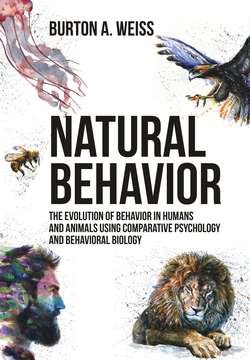Читать книгу Natural Behavior - Burton A. Weiss - Страница 9
На сайте Литреса книга снята с продажи.
ОглавлениеCHAPTER 2
Nature as the Subject
The Study of Nature
The study of nature is undertaken for many reasons. Humans have always had an interest in nature as the cave paintings by early people illustrate. People often identify with animals particularly in England, and with Disney encouragement, in the United States. Animal and human qualities are often intermixed as in mythology, astrology, and augury. People are also interested in learning how to use animals for food, clothing, and other products or as pets. However, the scientific study of nature is concerned with gaining knowledge as an aid to understanding organisms in their own right. Comparative study of many species, can lead to the discovery of general principles explaining the nature of all life. Practical considerations, like the application of bat sonar techniques to electronic guidance and detection systems, are the consequences, not the goals, of the basic study of nature and are possible only because of fundamental understanding.
Scientific understanding of nature comes from the use of the inductive and deductive methods in the pursuit of knowledge of nature. However, as in any human endeavor, scientists themselves often become embroiled in specific issues that retard progress. For nearly five decades, from about 1920 to 1960, a specific school of psychological thought called “learning theory” or behaviorism dominated the American psychological journals, excluding other work on animal behavior and wrongly emphasizing a strictly deductive approach employing laboratory studies and group statistics necessitated by the use of a single species, typically rats, but also pigeons and college students. When attempting to extract information in a study employing one species, statistics are required in order to discriminate between intra-species variation in the subjects and the effects of the conditions of the experiment.
The behaviorist position was incorporated into a narrow perspective of experimental techniques, even to the point of insisting upon two variables in defining an experiment (Underwood, 1966). Many areas such as comparative and physiological psychology avoided that error and continued to use all methods of science. Thus, Schneirla (Schneirla and Piel, 1948) investigated ants inductively in the jungles and deductively in the laboratory and co-authored a major comparative text (Maier and Schneirla, 1935) mainly covering research literature excluded from the psychological journals and without restrictive emphasis on any particular techniques. Wever (1949) used inductive and deductive techniques in the comparative study of hearing. Even among the behaviorists there were scientists like Skinner (1956) insisting on the importance of induction. The value of induction is clear from Darwin’s ideas on evolution and Einstein’s formulation of relativity both concepts produced inductively and not deduced from experiments, except in imagination.
In the 1930’s a mostly European school of biology, ethology, began to react against the narrow behaviorists’ view. The ethologists insisted on exclusive use of inductive techniques such as field observations of individual organisms, rarely rats, in their natural habitat. Later ethological field procedures were called ethograms. Laboratory techniques were scorned as artificial abstractions removed from natural surroundings. Complex statistical analysis was not needed even in studies of small groups or individuals because of the distinct differences among species.
By 1970, both schools had reached the more universal position of employing all the techniques of science in their work. Many strict behaviorists had adopted a more comparative approach, even though, to some that meant merely adding mice to rat laboratories. Ethologists began to employ laboratory methods. Just when the dispute appeared to have been transcended and synthesis of the schools was expected to allow the values, ideas, and knowledge of both to enhance the total understanding of nature, another group, sociobiology, began to exert influence.
Sociobiology was triggered by Hamilton (1964) who argued that bee worker castes evolved because the altruistic behavior of the workers in raising their sisters was adaptive. The adaptive feature depended on the concept that bee males, or drones, are haploid with all sperm identical. Workers, according to Hamilton, share the same diploid mother and identical genes from a common father, giving workers more genes in common with sisters than workers would have with their own offspring. Workers, thus, contribute more of their genes to the next generation by raising sisters than they would by reproducing themselves.
The unit in evolution is the population, not the individual. Variation in the population, not individual genes, is the central feature of evolution. In the example used by Hamilton that established the foundation for sociobiology, the bees, individual queens fly about 2.5 kilometers from their hives to mate in the air with 6 to 8 drones per flight for typically two flights. Mating with as many as 14 drones is common with all sperm stored together in the queen’s spermatheca. In addition, although workers are coded by odor to prevent drifting into alien hives, drones drift freely from hive to hive throughout the spring and summer months. Thus, they mate with unrelated queens from hives distant from the drone’s origin. Finally, the newly mated queen returns to her original hive which is vacated by the former queen with her fission swarm. The remaining workers then proceed to tend and raise the next brood, which is the progeny of the new queen and completely unrelated father drones. Therefore, bees are not closely related to hive mates as Hamilton supposed. Rather, genetic traits and even bee races are greatly mixed to provide population variation in each hive, as observations by apiarists confirm.
